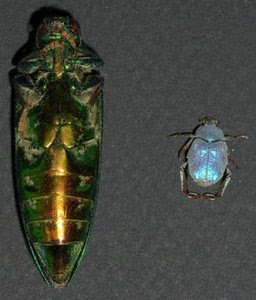Yes, this is something you never bothered to think about. Animals changing color. Though this is my first post related to biology, this is really interesting! Its about Beetles, the insect. Looking at the metallic woodboring Beetle head-on, the insect appears red. But viewing it from the side, the beetle starts to take on a greenish hue, and then turns completely green at an 80-degree angle! This color-changing property is called Iridescence, and scientists are taking notes from the beetle to make artificial iridescent materials.
Looking at the metallic woodboring Beetle head-on, the insect appears red. But viewing it from the side, the beetle starts to take on a greenish hue, and then turns completely green at an 80-degree angle! This color-changing property is called Iridescence, and scientists are taking notes from the beetle to make artificial iridescent materials.
Iridescence is an optical phenomenon characterized as the property of surfaces in which hue or the color changes according to the angle from which the surface is viewed (as may be seen of soap bubbles and butterfly wings).
Iridescence is caused by multiple reflections from multi-layered, semi-transparent surfaces in which phase shift and interference of the reflections modulates the incident light by amplifying or attenuating some frequencies more than others. (Don't scratch your head if you do not know what I mean)
In the first picture, Chrysochroa Vittata and Hoplia Coerulea (right), the insects possess natural photonic crystal structures which inspired the researchers to make artificial iridescent materials. A group of researchers from Belgium, has recently fabricated iridescent materials that closely mimic the structure and appearance of two species of Coleoptera beetles. By analyzing the underlying physical mechanisms that cause iridescence, the researchers can predict the colors displayed by specific material structures, and, conversely, determine what kind of structural properties are required to display certain colors.
A group of researchers from Belgium, has recently fabricated iridescent materials that closely mimic the structure and appearance of two species of Coleoptera beetles. By analyzing the underlying physical mechanisms that cause iridescence, the researchers can predict the colors displayed by specific material structures, and, conversely, determine what kind of structural properties are required to display certain colors.
See the video below to see how then viewing angle changes the color of a butterfly!
With this understanding, they have created a colorful variety of Iridescent materials!
In a recent issue of the New Journal of Physics, the scientists explain what causes the vivid colors to change based on viewing angle. The beetles in the study (Chrysochroa Vittata and Hoplia Coerulea) have layers of materials with different thicknesses.
When light waves reflect off the different layers at different depths, the light waves interfere. So when you look at a beetle, the color you see is due to the light’s reflection peak off not just one surface, but many surfaces combined. As your viewing angle increases from head-on to a side view, the reflectance peak shifts to shorter wavelengths.
That’s why Hoplia Coerulea, for example, appears blue head-on, but violet (shorter wavelengths) from larger viewing angles. For further explanation and more about Iridescence, see Physorg



No comments:
Post a Comment